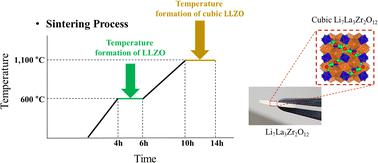当前位置:
X-MOL 学术
›
Phys. Chem. Chem. Phys.
›
论文详情
Our official English website, www.x-mol.net, welcomes your
feedback! (Note: you will need to create a separate account there.)
A strategy of enhancing the ionic conductivity of Li7La3Zr2O12 under accurate sintering conditions
Physical Chemistry Chemical Physics ( IF 2.9 ) Pub Date : 2022-11-29 , DOI: 10.1039/d2cp03072a Minjea Kim 1 , Hyun Gyu Park 1 , Kwangjin Park 1
Physical Chemistry Chemical Physics ( IF 2.9 ) Pub Date : 2022-11-29 , DOI: 10.1039/d2cp03072a Minjea Kim 1 , Hyun Gyu Park 1 , Kwangjin Park 1
Affiliation

|
Garnet-type Li7La3Zr2O12 (LLZO) oxide solid electrolytes are spotlighted as solid electrolytes for lithium-ion secondary batteries due to their high thermal and electrochemical stability. However, LLZO has a low ionic conductivity compared to liquid electrolytes, which is one of the biggest problems hindering the commercialization of all-solid-state batteries (ASSBs). Essential conditions for improving the ionic conductivity can be classified into two factors: (1) formation of a cubic LLZO phase related to bulk ionic conductivity and (2) formation of grain boundaries for low interfacial resistance. In this work, cubic LLZO phase formation conditions were first confirmed by TGA-DTA analysis. The LLZO phase was pre-formed via a holding range of furnace temperature profile (HRFTP) found by TGA-DTA analysis. The pre-formed LLZO phase could stabilize the cubic LLZO phase after a sintering process. This was confirmed by XRD analysis. Stabilized cubic LLZO under HRFTP conditions could enhance the bulk ionic conductivity, the main factor affecting the total ionic conductivity. In addition, to confirm the characteristics of sintering temperature changes, the grain boundaries of LLZO surfaces and the color of LZO pellets were investigated by SEM in detail. By setting the holding time process at 600 °C, the pre-formed LLZO phase stabilized the cubic LLZO phase formation after the sintering process. By optimizing the sintering temperature, both bulk and grain boundary ionic conductivities were improved. As a result, an ionic conductivity of 1.87 × 10−4 S cm−1 of the cubic LLZO phase was confirmed by EIS analysis. These results provide an insight into the reproducibility of the facile synthesis of LLZO. This strategy can be successfully applied to next-generation ASSBs.
中文翻译:

精确烧结条件下提高Li7La3Zr2O12离子电导率的策略
石榴石型 Li 7 La 3 Zr 2 O 12 (LLZO) 氧化物固体电解质由于其高热稳定性和电化学稳定性而作为锂离子二次电池的固体电解质受到关注。然而,与液体电解质相比,LLZO 的离子电导率较低,这是阻碍全固态电池 (ASSB) 商业化的最大问题之一。提高离子电导率的必要条件可分为两个因素:(1) 与体积离子电导率相关的立方 LLZO 相的形成和 (2) 低界面电阻的晶界形成。在这项工作中,首先通过 TGA-DTA 分析确认立方 LLZO 相形成条件。LLZO相是预先形成的通过TGA-DTA 分析发现的炉温曲线保持范围 (HRFTP)。预形成的 LLZO 相可以在烧结过程后稳定立方 LLZO 相。这通过 XRD 分析得到证实。在 HRFTP 条件下稳定的立方 LLZO 可以提高体积离子电导率,这是影响总离子电导率的主要因素。此外,为了确认烧结温度变化的特征,通过 SEM 详细研究了 LLZO 表面的晶界和 LZO 颗粒的颜色。通过将保温时间过程设置在 600 °C,预形成的 LLZO 相在烧结过程后稳定了立方 LLZO 相的形成。通过优化烧结温度,整体和晶界离子电导率均得到改善。结果,离子电导率为 1.87 × 10-4 S cm -1的立方LLZO相通过EIS分析确认。这些结果提供了对 LLZO 简便合成的重现性的深入了解。该策略可以成功应用于下一代 ASSB。
更新日期:2022-11-29
中文翻译:

精确烧结条件下提高Li7La3Zr2O12离子电导率的策略
石榴石型 Li 7 La 3 Zr 2 O 12 (LLZO) 氧化物固体电解质由于其高热稳定性和电化学稳定性而作为锂离子二次电池的固体电解质受到关注。然而,与液体电解质相比,LLZO 的离子电导率较低,这是阻碍全固态电池 (ASSB) 商业化的最大问题之一。提高离子电导率的必要条件可分为两个因素:(1) 与体积离子电导率相关的立方 LLZO 相的形成和 (2) 低界面电阻的晶界形成。在这项工作中,首先通过 TGA-DTA 分析确认立方 LLZO 相形成条件。LLZO相是预先形成的通过TGA-DTA 分析发现的炉温曲线保持范围 (HRFTP)。预形成的 LLZO 相可以在烧结过程后稳定立方 LLZO 相。这通过 XRD 分析得到证实。在 HRFTP 条件下稳定的立方 LLZO 可以提高体积离子电导率,这是影响总离子电导率的主要因素。此外,为了确认烧结温度变化的特征,通过 SEM 详细研究了 LLZO 表面的晶界和 LZO 颗粒的颜色。通过将保温时间过程设置在 600 °C,预形成的 LLZO 相在烧结过程后稳定了立方 LLZO 相的形成。通过优化烧结温度,整体和晶界离子电导率均得到改善。结果,离子电导率为 1.87 × 10-4 S cm -1的立方LLZO相通过EIS分析确认。这些结果提供了对 LLZO 简便合成的重现性的深入了解。该策略可以成功应用于下一代 ASSB。









































 京公网安备 11010802027423号
京公网安备 11010802027423号